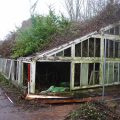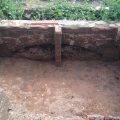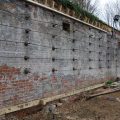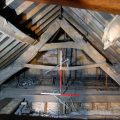Most of the archaeological work undertaken in Devon results from the planning process. A summary of work undertaken by Context One Archaeological Services Ltd in 2015 can be seen below. We hope to add summaries from other contractors in due course.
Post-medieval
The Glasshouses, Bicton College, East Budleigh, Colaton Raleigh, East Devon (SY 07036 86744 & SY 07084 86734)

Context One Archaeological Services Ltd carried out the final phase in a programme of historic building recording of Victorian glasshouses at Bicton College. The programme began in 2013 with an historic building evaluation to allow an assessment of the significance of three glasshouses. This was followed by an ongoing programme of building recording before, during and after dismantling of the buildings. The glasshouses dated between 1842 and 1889 and were situated within the northern side of an earlier walled garden, forming part of the Grade I listed Historic Park at Bicton (ref: 1000338).

The results of the assessment and building recording are summarized in last year’s Devon Archaeological Society Proceedings (2015). However, the discovery of a continuous run of vine arches in 2014 necessitated the re-designing of a new glasshouse, ensuring that the vine arches would be preserved in situ. Further archaeological work was also carried out in order to provide a more detailed record of the vine arches. At the outset of the construction programme in 2015, test-pits were excavated to fully record an exemplar vine arch from each glasshouse.

Archaeological monitoring and recording was also undertaken during the complete exposure of the vine arches prior to the installation of a protective gauge membrane between the Victorian walling and the new glasshouse foundations. With the exception of one small area of solid walling near the eastern end of the central glasshouse, the vine arches were found to run continuously beneath the dwarf front walls. The vine arches in one of the glasshouses were slightly different in design to those in the other glasshouses, with evidence of later modifications throughout.
A display board detailing the recording of the glasshouses is being installed by Devon County Council within the walled garden. (Cheryl Green)
Totnes Weir, Totnes (centred on SX 80062 61254)
Context One Archaeological Services Ltd carried out a programme of archaeological monitoring and recording during groundworks relating to the installation of a micro-hydropower scheme at Totnes Weir, Totnes.
A weir has been present on the Site since the 16th century (HER monument ID MDV9033, Swallowfield Weir) and although the structure has been subject to significant rebuilding, the structure retains historic fabric with the added potential for the exposure of earlier waterlogged timber structural material within or beneath the weir. The works identified a small number of stone and timber features, including the former fish run for the weir and some timbers within the stone structure of the sluice. The stone and timber elements which were observed and recorded within the sluice were thought to date to rebuilding in the late 19th century, which was followed by further extensive re-building in the late 20th century. No finds were observed or collected during the works. (Orlando Prestidge)
Rose and Crown, 52 Newport Road, Barnstaple (centred on NGR SS 56740 32191)
Context One Archaeological Services Ltd carried out a programme of historic building recording at the former Rose and Crown, 52 Newport Road, Barnstaple.

The programme began in 2014 with an historic building evaluation to allow an assessment of the significance of the former public house, the results of which are summarized in last year’s proceedings (2015). The evaluation confirmed that the Rose and Crown originated as a 16th or 17th century house, the roof retaining many elements of the late medieval structure. This was followed by a further phase of investigation to record a cross-section of one cruck truss and to carry out a full photographic survey of the roof structure. Although this has provided a more detailed record of the timbers and their form, which are to be retained within the building, the conclusions of the earlier work remain unaltered. The survey also revealed the roof has undergone significant repair and alterations, with many elements almost completely removed. With the exception of a small blocked square window with original wooden surround in the west gable wall of the roof, no additional historic fabric was exposed during the renovation work within the Rose and Crown. (Cheryl Green)
The Famous Ship, High Street, Exmouth (centred on SY 0013 8083)
Context One Archaeological Services Ltd carried out a programme of archaeological monitoring and recording relating to the demolition of a ground floor extension to the rear of The Famous Ship public house and construction of four dwellings.
No visible features or deposits of archaeological interest were encountered during the monitoring programme although a number of finds were observed and collected from waste deposition layers in the subsoil. The finds comprised some marine shell (cockles, scallops and oyster), mammal bone (cattle and cattle-sized mammal), post-medieval bottle glass, iron nails, clay pipe and pottery. The clay pipes were predominantly undiagnostic stem fragments, however there was a single bowl identified as an Atkinson and Oswald Type 33 bowl of late 19th century type with a heel and moulded geometric design around the entire surface of the bowl. The pottery included late medieval pale yellow and green glazed earthenware. The majority of the material were sherds of post-medieval earthenware jars including brown/yellow slipware; a few sherds of blue/white tin glazed and cream glazed earthenware (including tableware), and a single sherd of imported stoneware. (Orlando Prestidge)
The Former Glove Factory, Ladywell, Pilton, Barnstaple, (centred on NGR SS 55574 34156)
Context One Archaeological Services Ltd have been carrying out a programme of archaeological monitoring and recording during groundworks relating to the installation of services and construction of car parking areas for a residential development at the Former Glove Factory, Pilton.
Service trenches within the former factory building itself have revealed the remains of a tanning pit, comprising a stone feature, a channel and dark deposit. Further work will be carried out on the site during 2016 and a report will follow. (Orlando Prestidge)
South Molton Tannery, East Street, South Molton (centred on NGR SS 71980 25859)
Context One Archaeological Services Ltd carried out an historic building survey and desk-based assessment at the former South Molton Tannery, East Street, South Molton. The assessment comprised an historic building survey of the former tannery complex accompanied by a desk-based assessment.
Located within the South Molton Conservation Area, the study established that the tannery is an important late 19th century industrial complex which may incorporate late 17th century and certainly early to mid-19th century elements. It has enabled the tannery buildings to be more precisely dated and the relationship between them better understood. The photographic survey encapsulated the complex at the height of its operations in the last decade of the 19th century, the buildings and layout undergoing no discernible changes until it ceased to function as a tannery in 1954. Since then, the buildings interiors have undergone alterations to varying degrees in response to changing uses, however overall neither the buildings, the layout, nor the visual and historic setting have been compromised. Original features relating to the tanning process and considered to be of historic interest have also been recorded. (Cheryl Green)
Sydney House Car Park, Great Torrington (centred on SS 49432 18978)
Context One Archaeological Services Ltd carried out the first two phases in a programme of archaeological evaluation at Sydney House Car Park, South Street, Great Torrington. The Site is provisionally allocated for development within the Torridge District Council local plan (TDC 2012).
The first phase of archaeological work comprised the excavation of six trenches in the former market garden area within the western part of the Site. An amorphous spread of material was recorded in one trench at the horizon between the topsoil and subsoil, yielding a small assemblage of medieval pottery. This feature had no distinct cut edge but likely relates to medieval occupation either on or close to the Site.
The second phase of work comprised the excavation of five further trenches located within the centre of the car park revealing a small number of archaeological features. Two linear features (aligned approximately east-west) were identified in one trench at a depth of 0.70m below the modern ground surface, one of which contained a single sherd of post-medieval (likely 17th century) pottery. Several features of archaeological interest were identified within another trench at a depth of 0.70m below the modern ground surface, with a ditch (later cut by a pit) running across the eastern end. A number of finds were recovered from the ditch, including a variety of pottery sherds, butchered animal bone, oyster and mussel shells, glass and ceramic clay pipe. Some of the pottery sherds were very large and diagnostic, with a variety of glazed finishes. The remaining trenches were dominated by modern made ground which in places was up to 2.00m deep.
The site of a 17th century pottery kiln (HER no. 55053) is located immediately west of the Site and it is possible that some of the pottery may have derived from the kiln. However, overall the finds are indicative of medieval or post-medieval domestic activity. Indeed, a 17th century pottery and domestic refuse scatter (HER no. 19232) lies immediately east of the Site.
A further phase of works will evaluate the south-east corner of the Site, where it is anticipated that further archaeological features and deposits will be present. (Orlando Prestidge and Cheryl Green)
Undated
South Tawton Primary School, Tawton Lane, South Zeal, Okehampton (centred on SX 65099 93625)
Context One Archaeological Services Ltd carried out a programme of archaeological monitoring and recording relating to the demolition of temporary classrooms and construction of new classroom buildings and carpark at South Tawton Primary School, Tawton Lane, South Zeal, Okehampton.
A single archaeological feature was encountered during the monitoring programme. This comprised a linear stone feature constructed of a single width and depth of unmortared rubble. This ran continuously from north-east to south-west and likely formed the damaged base of a small boundary wall or stone-lined drain. No finds were observed, which prevented further analysis and dating of the stone feature. (Orlando Prestidge)